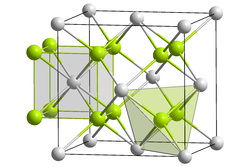 | |
| Names | |
|---|---|
| Other names Ytterbium difluoride | |
| Identifiers | |
3D model (JSmol) | |
| ChemSpider | |
PubChem CID | |
| |
| |
| Properties | |
| F2Yb | |
| Molar mass | 211.042 g·mol−1 |
| Appearance | gray crystals |
| Density | g/cm3 |
| Melting point | 1,407 °C (2,565 °F; 1,680 K) |
| Boiling point | 2,380 °C (4,320 °F; 2,650 K) |
| insoluble | |
| Structure [1] | |
| Fluorite structure | |
| Fm3m (No. 225) | |
a = 559.93 pm | |
Formula units (Z) | 4 |
| Related compounds | |
Other anions | Ytterbium(II) chloride Ytterbium(II) iodide |
Other cations | Samarium(II) fluoride Europium(II) fluoride Thulium(II) fluoride |
Related compounds | Ytterbium(III) fluoride |
Except where otherwise noted, data are given for materials in their standard state (at 25 °C [77 °F], 100 kPa). | |
Ytterbium(II) fluoride is a binary inorganic compound of ytterbium and fluorine with the chemical formula YbF2. [2] [3] [4]